Hydrangea Pleasures and Problems
Hydrangea Pleasures and Problems
Care and Questions in Early June
Our customers have many questions about Hydrangeas, so a Q&A about Cape Cod’s favorite shrub is timely throughout the year. Here are some of the concerns that we’re hearing about right now.
“Where’s the best place in the yard to plant blue Hydrangeas?”
The best location for a blue or pink Hydrangea is where it will get morning sun but afternoon shade. Late afternoon sun – after 4 PM – is fine too, but avoid full sun from 10 AM to 3 PM. Hydrangeas like well drained but organically amended soil, so create a bed that’s been improved with compost before planting. (Spreading 2-3″ of compost over the entire bed before planting is much better than only adding compost or peat in the hole.) After planting, apply an inch or two of bark mulch to help keep moisture in the soil.
Hydrangeas are not drought tolerant, so group them with other plants that appreciate regular irrigation, but set that irrigation so that it’s watering them deeply every five to seven days. Drip systems are good for these plants. (See leaf spot question below.)
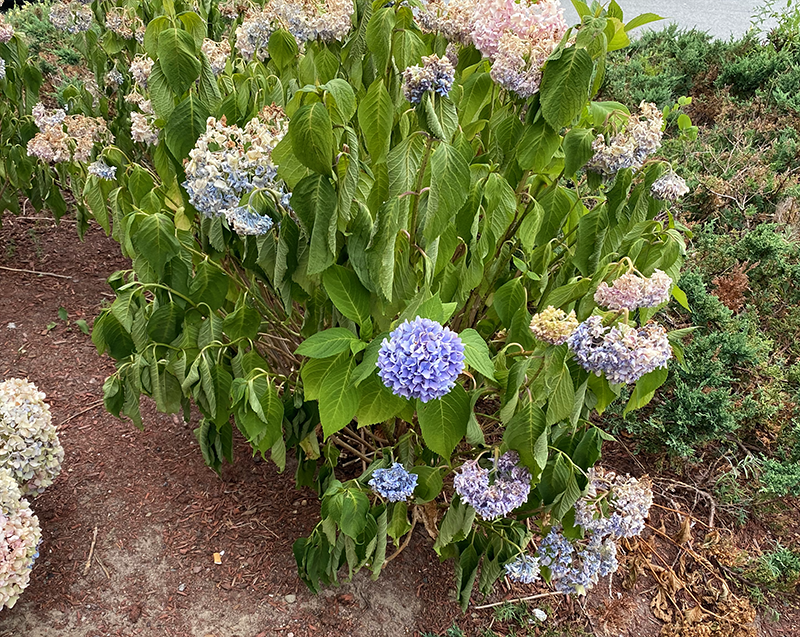
“My Hydrangea started to leaf out in May but that growth has stopped, and that foliage is now wilting and dying!”
In early June a healthy Hydrangea macrophylla, the blue or pink mopheads that we love, should be filled with leaves. The buds that produce both flowers and leaves on were formed on canes last summer, and if they made it through the winter, they should be fairly large in early June, with the very start of the flowers visible. (See photos below.)
Sometimes, however, some of those buds formed the previous summer will appear to have made it through the winter, beginning to open in May, only to stall, wilt and die in June. As the new growth grows from the bottom of the plant, it’s almost like the plant decides to put its energy into the new stems and abandon the growth up above. This can happen when those developing leaves get hit with cold, spring winds or near-freezing temperatures. Since the flower buds are in that growth on those canes (commonly called “old wood”) this means that the plant will have fewer or no flowers this summer. Although many people wait until the end of June to remove the dead canes, “just in case they come back,” there is nothing to be done but to prune out any stems where the buds and flowers have died. Varieties such as Endless Summer or Enchantress are less prone to this problem.
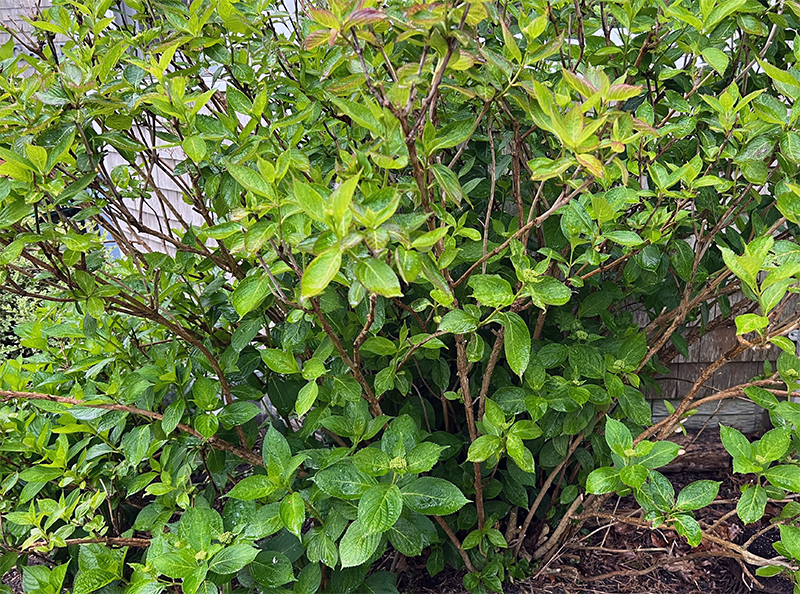
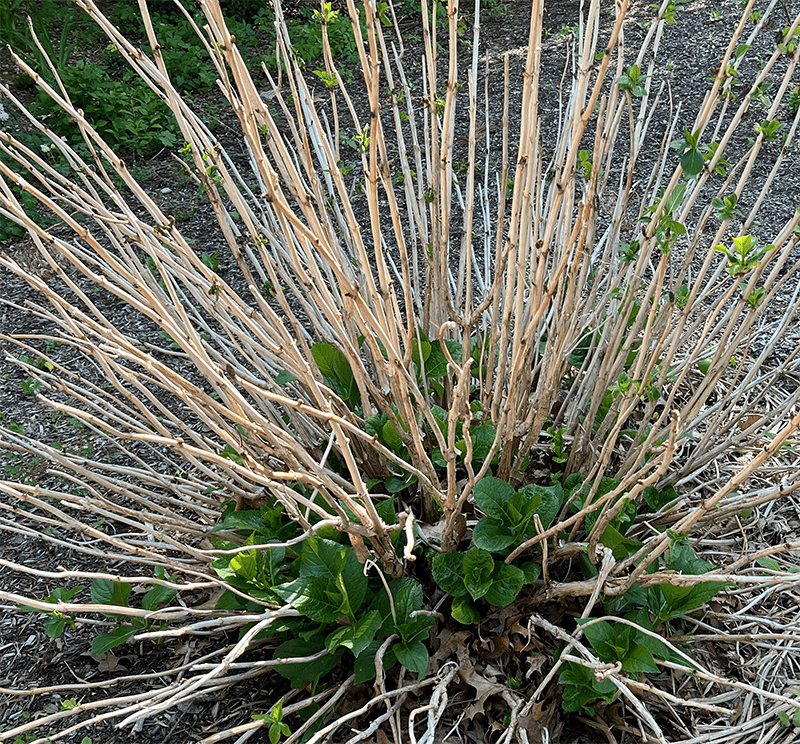
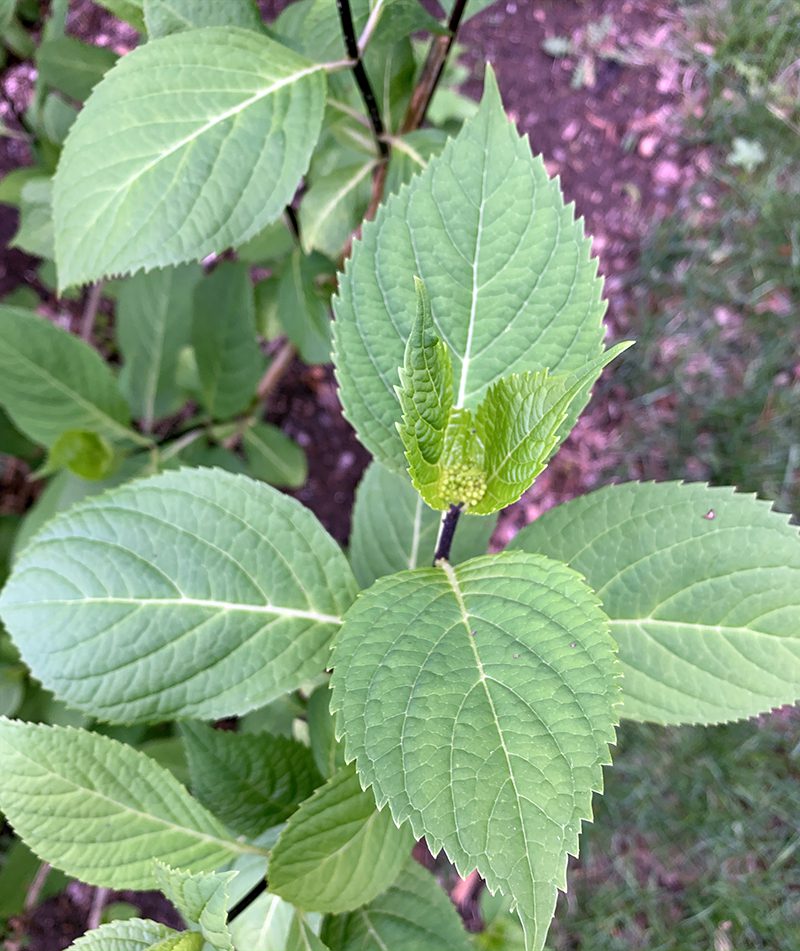
“What are the spots on my blue Hydrangea leaves?”
Hydrangeas are prone to leaf spot fungus when the leaves are frequently splashed with water. On Cape Cod, this happens early in the season because we usually have such cool, damp springs. Later in the summer this can happen if an irrigation system is hitting the leaves too often. While there is nothing you can do about the spring weather, be sure to water around these shrubs deeply but less often. If possible, use a drip system or soaker hoses around these plants.

“Why do the flowers on my Hydrangeas get brown by the end of July?”
The flowers on mophead and lacecap Hydrangeas last longest if the plants are growing in morning sun but afternoon shade. Although these shrubs will live in full sun, the flowers typically will wilt during the heat of the day when the sun is strongest. This frequent wilting causes the flowers to turn brown very quickly. The only cure is to move your plants to a place where they are sheltered from the mid-day sun.
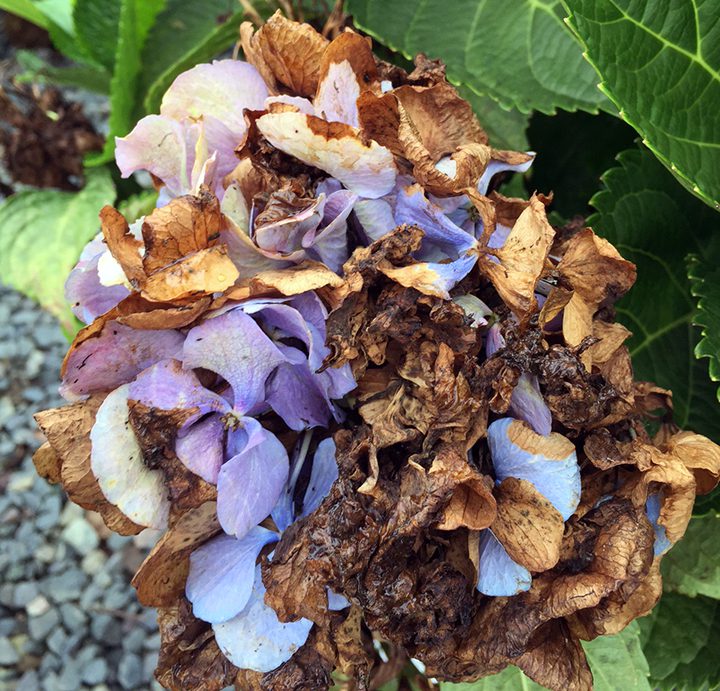
“My Hydrangea flowers are opening green instead of blue. Why?”
Whether you’re growing blue or pink Hydrangeas, know that the flower color takes time to develop. It’s typical that the flowers begin to open with white, cream or greenish petals. The other colors will deepen over a period of two to four weeks. Greenish flowers early in June do not mean that you need to add aluminum or sulfur to the soil.
To see a handout about Hydrangea color, click here.
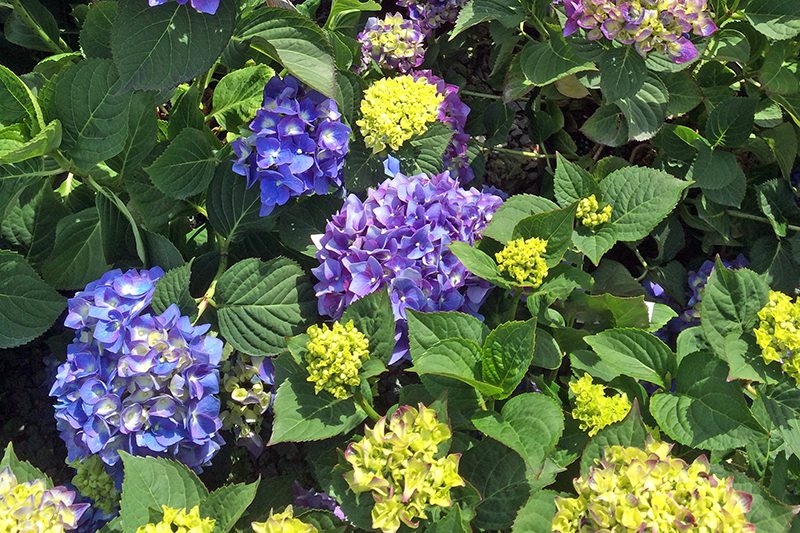
“My neighbor just planted Hydrangeas that are in full bloom, but the ones in my yard aren’t visible yet. Is there something wrong with mine?”
Most nurseries and garden centers get in plants that already have flowers on them, because customers like to see a bloom before they buy. But in May and June, these plants are more mature than the ones in the landscape. Mophead and lacecap varieties on Cape Cod begin to show color at the end of June, as do the smooth Hydrangeas such as Annabelle and Invincibelle Spirit. Panicle varieties such as Limelight, and Bobo don’t begin to flower until the end of July, although some paniculata types (Quick Fire, Little Quick Fire, and Firelight) will show flowers in the middle of that month.
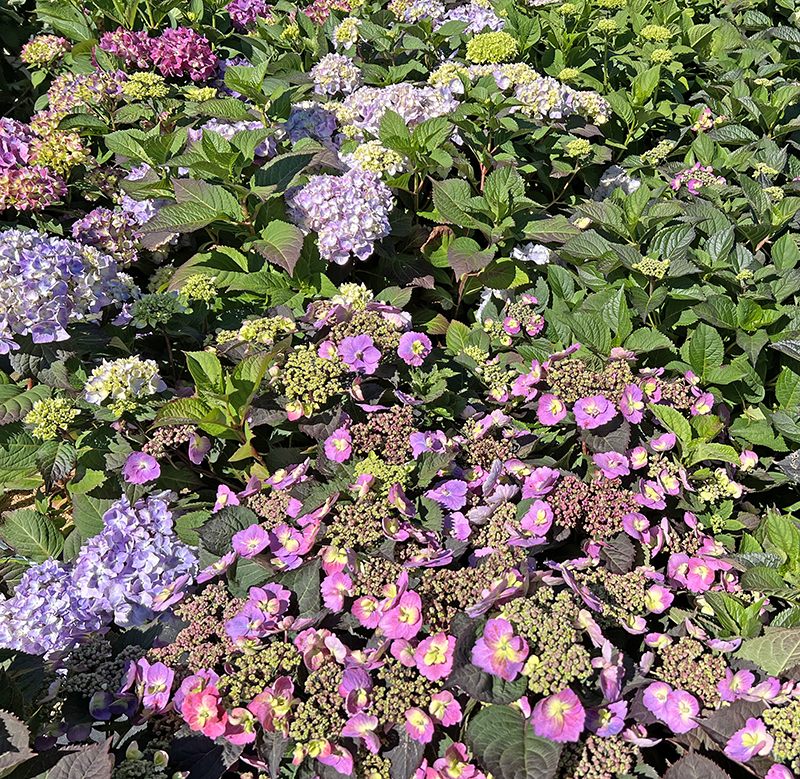
“How can I learn more about Hydrangeas?”
Since this is Cape Cod’s signature plant, we offer many educational sessions throughout the year about these plants. Watch our Events page for upcoming classes and virtual happy hours about Hydrangeas. You can also join the Cape Cod Hydrangea Society to get information about their meetings and newsletter. Watch for the various events and open gardens during the Cape Cod Hydrangea Festival. Hyannis Country Garden is proud to be a major sponsor of the Hydrangea Fest and will have special exhibits and talks during those ten days in July.
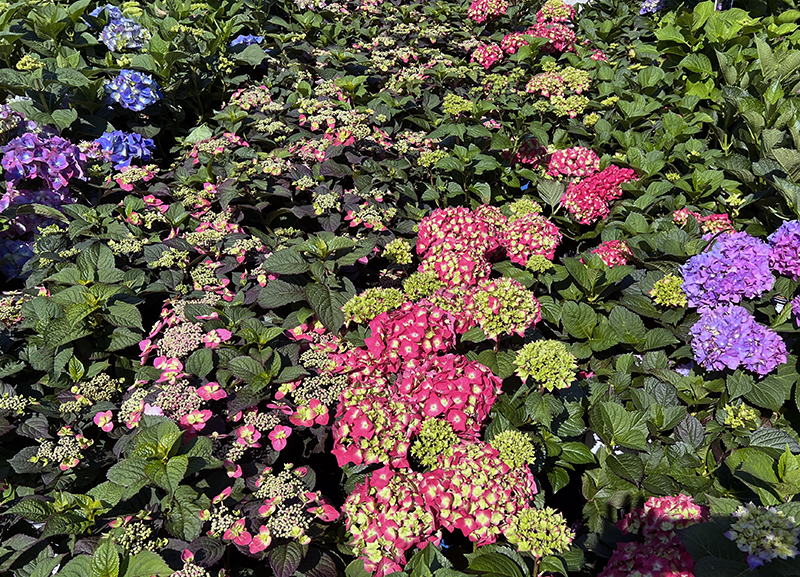
9 Comments
Leave a Comment
Subscribe To Our Newsletter
Sign up for our weekly email about sales and events.

When is it ok to trim the cane on my lace cap hydrangeas?
The only trimming you should do on these is removal of dead canes. Do not trim them down. There is no way to make them shorter, and if you time them back they will be just as tall by mid-summer with far fewer flowers. Best time to remove dead parts is late May, but you can still do that now.
Great article – very informative!
Thank you!
Martha Meier
North Chatham, MA 02650
Very helpful information , clearly explained and illustrated. I have several types of hydrangeas. My one hydrangea that is having difficulty is the one with variegated leaves. It seems that slugs or some insects are particularly attracted to the variegated variety. Any truth to that?
Cat,
Yes, the white parts on many variegated plants are favorites for earwigs and slugs, to name just two. You can dust with Diatomaceous Earth (DE) to try and stop the damage. Dust on dry day when rain isn’t expected
Our young landscaper cut all of the 8( mature blooming beautifully last summer) hydrangeas down to 3 inches last fall when we were away. Needless to say, this summer we have NO blooming hydrangeas. Is there anything we can do for next season?
Well, for starters, educate your landscaper not to cut it down! (Which I’m sure you knew.) Leave it all there, and next May when the newly opening leaves are the size of a dime, you can prune out any dead canes. Never do any pruning of this plant in the fall or too early in the spring. Right now your plant is creating the buds for next year’s flowers where the leaves meet the stems…if you look closely you’ll see the tiny buds there. As long as those buds don’t get zapped in the winter by very cold temperatures, your shrub will flower next summer.
Could you address how to move or transplant? I have very mature plants that need to live elsewhere in the yard due to home remodel/expansion. /Assume that would be done in the fall?
Yes, you would transplant in the fall. Dig all around the plant, at least six inches out from the stems, and then underneath, trying to go down about 12″ to get as much of the roots as possible. Once you have the ball of roots loose from the ground, sometimes it’s easiest to pull that heavy ball onto a tarp and then drag it to the new location. Dig the new hole and place the plant there, making sure that it’s at the same level. (In other words, don’t dig the hole too deep or too shallow so that the plant is either sunken or raised up above the soil line.) Water well right after planting. You can scatter some Bio-Tone in the hole before placing the plant, and mulch around it with compost this fall and with an inch of bark mulch next spring.